Katie Wyssmann

Amour Mickala (Université des Sciences et Techniques de Masuku, Gabon)
I am a PhD student at the Masuku University of Science and Technology (USTM) in Gabon, in the Department of Biology, Biology section of the Populations and Ecosystems option Biology and Ecology of Animal Communities. My research for my doctoral studies is focused on studying mandrills (Mandrillus sphinx) and their conservation using non-invasive genetic approaches. More specifically, my thesis is focused on using non-invasive genotyping to assess the relatedness structure of a focal horde of wild mandrills and to estimate the genetic effective and census population size of this population. I am also integrating different non-invasive approaches to answer questions related to the mechanisms of inbreeding avoidance in wild mandrills of the Lopé National Park in Gabon.
I am a PhD student at the Masuku University of Science and Technology (USTM) in Gabon, in the Department of Biology, Biology section of the Populations and Ecosystems option Biology and Ecology of Animal Communities. My research for my doctoral studies is focused on studying mandrills (Mandrillus sphinx) and their conservation using non-invasive genetic approaches. More specifically, my thesis is focused on using non-invasive genotyping to assess the relatedness structure of a focal horde of wild mandrills and to estimate the genetic effective and census population size of this population. I am also integrating different non-invasive approaches to answer questions related to the mechanisms of inbreeding avoidance in wild mandrills of the Lopé National Park in Gabon.
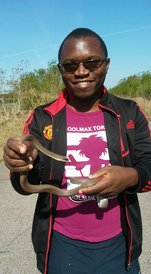
Geraud Tasse (University of Buea, Cameroon)
I am a PhD student at the University of Buea in the Department of Zoology and Animal Physiology and a Researcher at the Ore processing Laboratory under the Institute of Geology and Mining Research in Yaounde, Cameroon. My research interest is primarily on amphibians and their conservation but also on the use of various spatial analytical approached in understanding patterns and conservation of biodiversity under climate change in the tropics. My thesis focuses on amphibians in general and more on the golden puddle frog Phrynobatrachus auritus. I integrate various spatial analytical approaches to answers questions related to the life history, distribution and the need for conserving the puddle frog and at a larger scale, other amphibians in a hotspot of biodiversity in Cameroon.
I am a PhD student at the University of Buea in the Department of Zoology and Animal Physiology and a Researcher at the Ore processing Laboratory under the Institute of Geology and Mining Research in Yaounde, Cameroon. My research interest is primarily on amphibians and their conservation but also on the use of various spatial analytical approached in understanding patterns and conservation of biodiversity under climate change in the tropics. My thesis focuses on amphibians in general and more on the golden puddle frog Phrynobatrachus auritus. I integrate various spatial analytical approaches to answers questions related to the life history, distribution and the need for conserving the puddle frog and at a larger scale, other amphibians in a hotspot of biodiversity in Cameroon.
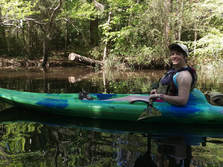
Anna Weber
My career in biological research began during my undergraduate studies at Alma College, located in central Michigan. I had the opportunity there to be part of several field research projects, including studying elephant behavior in Thailand, predator surveys in Victoria Falls, Zimbabwe, and banding birds in Michigan, Canada, Ecuador, and later in Yosemite National Park. After my graduation in 2015, I started to learn about the usefulness of molecular tools in ecology and conservation, and I began to search for graduate programs that would allow me to combine my interests in both field ecology and genetics. That search led me to pursue a Master’s degree in Dr. Anthony’s lab at UNO.
I am generally interested in ecology, conservation, and public education and outreach. My current research focuses on inbreeding prevalence, relatedness, and mate choice in mandrills, a large species of monkey, in Lopé National Park, Gabon. Specifically, I aim to determine whether female mandrills choose mates based on genetic dissimilarity in the major histocompatibility complex (MHC), a set of genes with important immune functions. As part of a collaboration and fellowship with the Audubon Nature Institute, I am also engaged in a study evaluating the impacts of environmental contamination on reptile communities at Bayou Sauvage National Wildlife Refuge here in Louisiana.
My career in biological research began during my undergraduate studies at Alma College, located in central Michigan. I had the opportunity there to be part of several field research projects, including studying elephant behavior in Thailand, predator surveys in Victoria Falls, Zimbabwe, and banding birds in Michigan, Canada, Ecuador, and later in Yosemite National Park. After my graduation in 2015, I started to learn about the usefulness of molecular tools in ecology and conservation, and I began to search for graduate programs that would allow me to combine my interests in both field ecology and genetics. That search led me to pursue a Master’s degree in Dr. Anthony’s lab at UNO.
I am generally interested in ecology, conservation, and public education and outreach. My current research focuses on inbreeding prevalence, relatedness, and mate choice in mandrills, a large species of monkey, in Lopé National Park, Gabon. Specifically, I aim to determine whether female mandrills choose mates based on genetic dissimilarity in the major histocompatibility complex (MHC), a set of genes with important immune functions. As part of a collaboration and fellowship with the Audubon Nature Institute, I am also engaged in a study evaluating the impacts of environmental contamination on reptile communities at Bayou Sauvage National Wildlife Refuge here in Louisiana.
Courtney Miller
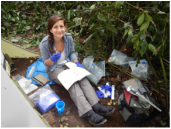
I received my undergraduate degree in Interdisciplinary Studies with a major in Environmental Studies here at UNO. I took part in a variety of research projects as an undergrad including my senior honors thesis on parasitism rates and host specificity of Honduran bat flies and a collaborative project on feral hog abundance and distribution in LaFitte national park. After spending a year as an undergraduate research assistant in Dr. Anthony’s lab, I was delighted to transition to the Ph.D. program and joined the Central Africa PIRE project in Spring 2015. I am generally interested in the influence of human activities (such as climate change and urban expansion) on biodiversity, evolutionary processes, wildlife disease, and ecosystem functioning. Within these interests I hope to explore ways in which interdisciplinary approaches and international collaboration can benefit conservation efforts.
My Ph. D. research is based on three projects in Central Africa. The first project involves mapping patterns of genomic variation within one of the PIRE project’s focal taxa, the Golden Puddle Frog Phrynobatrachus auritus, throughout Cameroon and Gabon. The goal is to combine these results with that of other focal taxa to identify areas of elevated adaptive potential and highlight areas for conservation under future climate projections. The second project involves modeling the distribution of the amphibian chytrid fungus Batrachochytrium dendrobatidis (Bd) in Cameroon. The objective is to determine whether the distribution of Bd is associated with one or more environmental variables and produce a spatial map of its likely distribution under current and future climate conditions that could be used to influence amphibian conservation efforts. The final project is focused on mapping amphibian beta diversity across the Congo basin and predicting how different amphibian functional groups will respond to climate change.
My Ph. D. research is based on three projects in Central Africa. The first project involves mapping patterns of genomic variation within one of the PIRE project’s focal taxa, the Golden Puddle Frog Phrynobatrachus auritus, throughout Cameroon and Gabon. The goal is to combine these results with that of other focal taxa to identify areas of elevated adaptive potential and highlight areas for conservation under future climate projections. The second project involves modeling the distribution of the amphibian chytrid fungus Batrachochytrium dendrobatidis (Bd) in Cameroon. The objective is to determine whether the distribution of Bd is associated with one or more environmental variables and produce a spatial map of its likely distribution under current and future climate conditions that could be used to influence amphibian conservation efforts. The final project is focused on mapping amphibian beta diversity across the Congo basin and predicting how different amphibian functional groups will respond to climate change.
Christie Sukhdeo
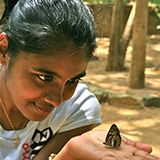
I have a broad interest in the fields of ecology, evolution, and conservation biology of tropical forest fauna. I especially like working with insects! I graduated from the City College of New York at the City University of New York in 2011 with a B.S. in Biology and initial certification in secondary education. I joined the Anthony Lab at UNO in Fall 2012 as a Ph.D student and NSF graduate research fellow. In the past, I have conducted research on the phylogeography of a widespread tropical butterfly Melanitis leda. I have also participated in a Buddhism and biodiversity conservation project in Southeast Asia, specifically in Sri Lanka and Thailand. For my Ph.D thesis project, I am working on mapping patterns of dung beetle beta diversity across West and Central Africa. I have also used a comparative phylogeographic approach to understand the role of montane speciation in three widespread dung beetle species and investigated the impacts of mammal hunting on dung beetle communities in central African forests. For more about me, please visit my website.
Trent Santonastaso
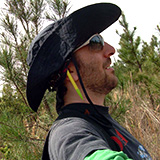
I received a BS in biology from Penn State with a minor in geology. Upon graduation, I worked as a chemist in an environmental lab, and volunteered in the collections department of the Field Museum of Natural History. Twelve years later, I returned to school and graduated from Northeastern Illinois University with an MS in Biology with an emphasis in ecology. While working on my thesis “Population Structure of Wild Raccoons (Procyon lotor) from Various Habitat Types across the Chicago Area Using Molecular Techniques”, I participated in a project parsing out Sedum conspecifics, and worked as a field scientist for an environmental company.
After graduation I was hired as a lab manager in the genetics lab of the Brookfield Zoo. Aside from routine paternity testing, our bigger projects included determining migration patterns of wild lions throughout Central Africa and conducting an exhaustive parentage analysis of the entire North American captive population of Ringtail Lemurs. Before returning to Graduate School at the University of New Orleans, I also constructed a microsatellite library for the critically endangered Swamp Metalmark butterfly at the Peggy Notebaert Nature Museum, and worked in a high-throughput cancer research facility at Northwestern University where I was responsible for FISH and TUNEL analyses, laser capture, immunohistochemistry titrations, cell culturing, and tissue banking. My PhD thesis focuses on three components of reptile immunity. Firstly, I have examined the impact of island fragmentation on MHC diversity in a widespread reptile Podarcis erhardii. Secondly, I have been characterizing the MHC class II complex in the reptile genome. Lastly, I have been working on a project to examine the effects of spatial and temporal variation in pathogen pressure on MHC variation in an endemic anole native to the island of Saba.
After graduation I was hired as a lab manager in the genetics lab of the Brookfield Zoo. Aside from routine paternity testing, our bigger projects included determining migration patterns of wild lions throughout Central Africa and conducting an exhaustive parentage analysis of the entire North American captive population of Ringtail Lemurs. Before returning to Graduate School at the University of New Orleans, I also constructed a microsatellite library for the critically endangered Swamp Metalmark butterfly at the Peggy Notebaert Nature Museum, and worked in a high-throughput cancer research facility at Northwestern University where I was responsible for FISH and TUNEL analyses, laser capture, immunohistochemistry titrations, cell culturing, and tissue banking. My PhD thesis focuses on three components of reptile immunity. Firstly, I have examined the impact of island fragmentation on MHC diversity in a widespread reptile Podarcis erhardii. Secondly, I have been characterizing the MHC class II complex in the reptile genome. Lastly, I have been working on a project to examine the effects of spatial and temporal variation in pathogen pressure on MHC variation in an endemic anole native to the island of Saba.
Dr. Katy Morgan
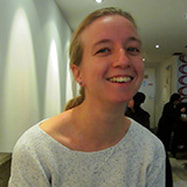
I have broad interests in molecular ecology, conservation and population genetics, and tropical biodiversity. During my PhD I worked on Anopheles mosquitoes within Southeast Asia, focussing on the roles of historical climate change and ecological heterogeneity in driving population divergence and speciation. After receiving my PhD from The University of Manchester, I moved to the Max Planck Institute in Tübingen to begin working on the population genetics and genomics of island nematodes.
I joined the Anthony lab in May 2013, excited by the opportunity to move into conservation genetics. I have carried out genomic and phenotypic work for two of the nine CAB-Alliance focal taxa: the soft furred mouse, Praomys misonnei, and the blue duiker, Philantomba monticola. The main aim of my work is to identify and characterize patterns of adaptive diversity across the Central African landscape as well as identify areas of genomic vulnerability where populations will have the greatest challenges to adapt to environmental change. I also have a keen interest in the capacity building and international collaboration aspects of the CAB-Alliance project, and have been involved in the organisation of field expeditions and undergraduate field courses in both Gabon and Cameroon.
I joined the Anthony lab in May 2013, excited by the opportunity to move into conservation genetics. I have carried out genomic and phenotypic work for two of the nine CAB-Alliance focal taxa: the soft furred mouse, Praomys misonnei, and the blue duiker, Philantomba monticola. The main aim of my work is to identify and characterize patterns of adaptive diversity across the Central African landscape as well as identify areas of genomic vulnerability where populations will have the greatest challenges to adapt to environmental change. I also have a keen interest in the capacity building and international collaboration aspects of the CAB-Alliance project, and have been involved in the organisation of field expeditions and undergraduate field courses in both Gabon and Cameroon.
Dave Weber
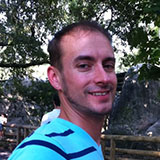
I was born and raised in rural Pennsylvania. After graduating from High School I moved to Baltimore, Maryland, where I studied at the Baltimore City Community College and received and Associates Degree in Art. It was at the Baltimore City Community College where I realized my love for Biology. After Graduating I spent three terms with AmeriCorps. It was with AmeriCorps that I made my first visit to Louisiana, and fell in love with its culture and environment.
In 2010 I began working on a Bachelor’s of Science at The University of New Orleans. Having received my degree in 2013, I continued work on my Masters at UNO and graduated in 2017. My primary interest is in ecology and evolutionary Biology, with a strong interest in conservation. My Master's thesis was on the influence of relatedness and size on the spatial distributions of individuals within an urban population of Anolis carolinensis lizards in New Orleans. I am currently a Ph. D. student in the Biology Department at the University of Maryland.
In 2010 I began working on a Bachelor’s of Science at The University of New Orleans. Having received my degree in 2013, I continued work on my Masters at UNO and graduated in 2017. My primary interest is in ecology and evolutionary Biology, with a strong interest in conservation. My Master's thesis was on the influence of relatedness and size on the spatial distributions of individuals within an urban population of Anolis carolinensis lizards in New Orleans. I am currently a Ph. D. student in the Biology Department at the University of Maryland.
Dr. Rachel Clostio (Wallace)

I graduated from the University of New Orleans in 2009 with a PhD. in Conservation Biology. My research focused on population and landscape genetics of the federally threatened gopher tortoise (Gopherus polyphemus). My primary objective was to provide useful data on genetic population structure to management entities, such as the U.S. Fish and Wildlife Service, which could be used guide recovery efforts. In addition to evaluating population structure, I utilized novel GIS tools to correlate specific landscape features with genetic data and identify possible barriers to gene flow. I also examined the relationship in gopher tortoises between seroprevalence of Mycoplasma agassizii, the causative agent of upper respiratory tract disease, and several environmental variables.
My general interests include population genetics, phylogeography, landscape genetics, emerging infectious diseases in wildlife, and host-pathogen cophylogeny. Following the completion of my dissertation, I worked as a postdoctoral researcher in the lab of Dr. Crystal N. Johnson at Louisiana State University from 2009-2012. There I studied genetic diversity of pathogenic Vibrios. I am currently a research assistant in the lab of Dr. Scott France examining the population genetics of deep sea corals.
My general interests include population genetics, phylogeography, landscape genetics, emerging infectious diseases in wildlife, and host-pathogen cophylogeny. Following the completion of my dissertation, I worked as a postdoctoral researcher in the lab of Dr. Crystal N. Johnson at Louisiana State University from 2009-2012. There I studied genetic diversity of pathogenic Vibrios. I am currently a research assistant in the lab of Dr. Scott France examining the population genetics of deep sea corals.
Anne Davis (Johnston)
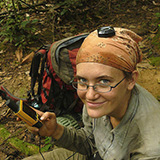
As an undergrad and master’s student in the Anthony lab, I worked on three main projects: 1) Assessing the utility of COXI barcodes for the global regulation of the bushmeat trade of duiker antelope (Cephalophinae) 2) Species tree estimation and dated divergence times of Cephalophinae: evidence of Pleistocene speciation 3) Species identification and genotyping of scat from sympatric Central African duikers. Presently, I am interested in studying the population structure of Peter’s duiker (Cephalophus callipygus) across an ecological gradient in Lope National Park, Gabon. I also work remotely for the Epps lab at Oregon State University genotyping scat of the American pika (Ochotona princeps) for a project that aims to better understand connectivity and potential impact of climate change on this species.
Dr. Iván Soto Calderón
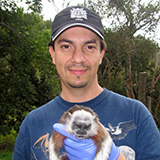
I am originally from Medellín, Colombia. As an undergraduate biology student, I took multiple courses involving field work, ecology, molecular analysis and evolution. Still as an undergraduate, I joined the Molecular Genetics lab (GENMOL) at the University of Antioquia, where I developed my skills in molecular techniques and I had the opportunity to do my undergrad thesis studying the anthropological genetics of native Colombians. After that, I had the opportunity to get my Master degree integrating molecular and historical data to study the historical demography of a human isolate in Antioquia, northwest Colombia. I've also collaborated with projects in population genetics of bats (Myotis), magnolias (Dugandiodendron), African duikers (Cephalophus) and Malagasy butterflies (Heteropsis). More recently, I obtained my PhD degree addressing the evolutionary dynamics of nuclear translocations of mtDNA (NUMTs) in African Great Apes, the risk of contamination of mtDNA databases with these sequences and their potential as cladistic markers.
I currently hold a faculty position at the University of Antioquia. I am studying the genetic structure of the endangered white-footed tamarin (Saguinus leucopus), an primate species endemic to NW Colombia. I have broad interests in the biological diversity in the tropics, integrating genetic tools and field data to assess processes of diversification.
I currently hold a faculty position at the University of Antioquia. I am studying the genetic structure of the endangered white-footed tamarin (Saguinus leucopus), an primate species endemic to NW Colombia. I have broad interests in the biological diversity in the tropics, integrating genetic tools and field data to assess processes of diversification.
Dr. Stephan Ntie

Stephan Ntie is a former graduate student in the lab, and has worked with Dr. Anthony since July 2005 (though he started in UNO PhD program only in August 2006 because of Hurricane Katrina). His interests include conservation and evolutionary biology, population genetics, molecular phylogeography, and tropical ecology.
He was involved in studying the historical biogeography of forest antelopes (cephalophinae) in central African rainforest using non-invasive techniques. In the past, Stephan Ntie has been a research intern in the Centre International de Recherches Médicales de Franceville (CIRMF), Gabon for 10 months and a research trainee for one month at the Centre d’Ecologie Fonctionnelle et Evolutive (CEFE, CNRS), Montpellier, France. Outside the lab, he was also a member of the New Orleans Society for Conservation Biology (SCB), American Society of Naturalist (ASN), and Society for the Study of Evolution (SSE).
After his graduation in August 2012, Stephan Ntie went back to his home country where he has been appointed to a permanent position as "Enseignant-Chercheur" in the biology department of the Université des Sciences et Techniques de Masuku (USTM), Franceville, Gabon.
He was involved in studying the historical biogeography of forest antelopes (cephalophinae) in central African rainforest using non-invasive techniques. In the past, Stephan Ntie has been a research intern in the Centre International de Recherches Médicales de Franceville (CIRMF), Gabon for 10 months and a research trainee for one month at the Centre d’Ecologie Fonctionnelle et Evolutive (CEFE, CNRS), Montpellier, France. Outside the lab, he was also a member of the New Orleans Society for Conservation Biology (SCB), American Society of Naturalist (ASN), and Society for the Study of Evolution (SSE).
After his graduation in August 2012, Stephan Ntie went back to his home country where he has been appointed to a permanent position as "Enseignant-Chercheur" in the biology department of the Université des Sciences et Techniques de Masuku (USTM), Franceville, Gabon.
Dr. Kimberly Terrell
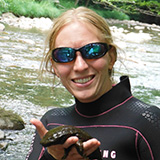
As a wildlife physiologist, I work at the interface of animal health and environmental change. My research utilizes a comparative, cross-species approach to answer questions that are relevant to both basic physiology and applied conservation. My dissertation research was conducted under the mentorship of Dr. Barry Bavister and Dr. Nicky Anthony, through a partnership between UNO and the Smithsonian Conservation Biology Institute (Front Royal, VA). I investigated the genetic and physiological determinants of male reproductive fitness in the cheetah and domestic cat (meaning that I can tell you more than you’ll ever want to know about cat sperm). Although my research was entirely lab-based, this experience sparked my interest in the connection between basic animal physiology and the large-scale, complex threats facing wild populations. I am now based at the Smithsonian’s National Zoo (Washington, DC) and am fortunate to be supported by a David H. Smith Fellowship (www.smithfellows.org). I lead the zoo’s Salamander Conservation Program, and my research focuses on understanding how climate change will affect metabolism and disease-resistance in hellbenders. You can learn more about my current work at www.salamanderscience.com. More recently, I took up the position of Director of Research and Conservation at the Memphis Zoo.
